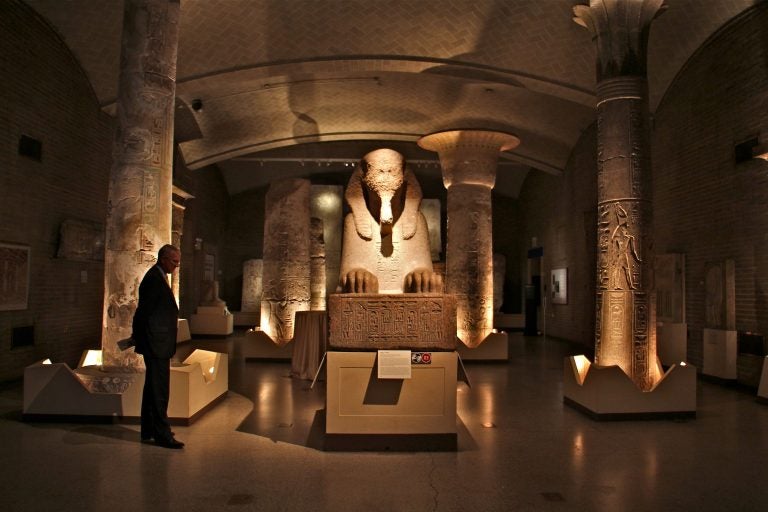After a century in the limelight, ancient Egyptian sphinx going back into hiding
Penn Museum's iconic, 3,200-year-old Egyptian sphinx will disappear for several years, starting Monday, while its gallery undergoes renovations.
Listen 2:10
The Penn Museum is launching a major renovation that promises to "transform the visitor experience." (Emma Lee/WHYY)
After this weekend, it will be years before visitors to the Penn Museum in Philadelphia will be able to see its ancient sphinx.
The Lower Egyptian gallery of the Museum of Archaeology and Anthropology at the University of Pennsylvania is about to undergo extensive renovations, expected to last several years.
The gallery was constructed around the 13-ton sphinx where it was placed in 1926. It hasn’t budged since; it cannot be removed without demolishing a large portion of the museum.
The renovations may push the sphinx around the space a bit, but it’s not going anywhere. It has been part of the life of Philadelphia for more than a century.
The Sphinx of Ramses the Great had a full life before it arrived at a Philadelphia port in 1913. The red granite sculpture guarded a temple in Egypt for 3,200 years before a British archaeological expedition discovered it buried in sand near the ancient city of Memphis and shipped it by steamer to the other side of the world.
As soon as the sphinx arrived in the Philadelphia port, city residents immediately adopted it. Most people would never have had the opportunity to travel to Egypt, so to have such a formidable and exotic artifact as a new neighbor caused a sensation.
The sphinx was perched in the museum garden, inside the building’s vestibule, and finally landed in 1926 in the Lower Egyptian Gallery where it has overseen decades of dinners, lectures, and receptions. It stars in a series of online video courses on Egyptology through Coursera, taught by Penn’s David Silverman.
The sphinx has also witnessed personal milestones of countless people who have used the space for marriage proposals, weddings, and — according to associate curator Jennifer Wegner — at least one funeral. People seem to want to stand next to it when they are doing something important.
“There’s something about the way our sphinx looks,” said Wegner. “He’s serene. There’s an idea of eternity about him. If you’re getting married, you want your union to last as long as the sphinx has lasted.”
A silent guest
Mia Rose Briglia had been planning her wedding with her then-fiancé Anthony for this October, but due to the pending closure of the hall was forced to move her ceremony up six months — to April — in order to get in before the renovations started. No other venue would do.
Briglia was attracted to both the hall’s ambience — the warm, dim lighting and high ceilings make it romantic — and its gravitas. She was committed to making her vows at the feet of the ancient sphinx.
“Neither me nor my fiancé attend a church or anything,” she said. “To have a space that still feels somewhat sacred, with so much history there, you feel that.”
One of the most recent weddings to take place at the museum was on May 19, when Jarcy Zee and Parag Mahajan were married.
They combined her Chinese and his Indian traditions in a cultural soup: the groom arrived in Stoner Courtyard on the back of a white horse; the American-style ceremony took place under the domed ceiling of Pepper Hall; and, afterwards, the guests sat for a traditional Chinese tea.
Their families gathered and exchanged wedding toasts in front of the sphinx.
“We had Chinese, we had Indian, we had American, and we had the Egyptian room,” said Zee. “We thought it was kind of cool to have our wedding in these different spaces.”
Theirs may be the last wedding there. While the details have not yet been finalized, the Lower Egyptian Gallery will be redesigned to focus primarily on funerary artifacts and mummification, and to orient museum-goers to the rest of the Egyptian showcase in the Upper Egyptian Gallery.
The sphinx may, or may not, be able to oversee large events in the future.
WHYY is your source for fact-based, in-depth journalism and information. As a nonprofit organization, we rely on financial support from readers like you. Please give today.





